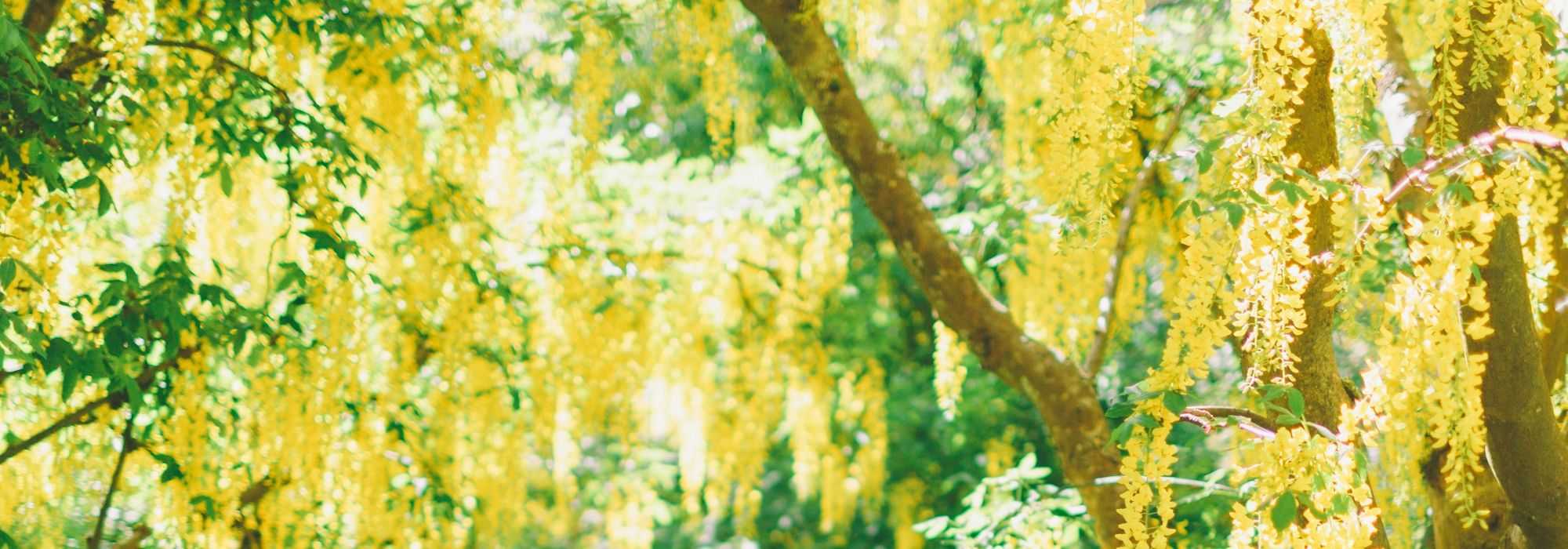
Laburnum: planting, pruning and care
Contents
Cytisus in a nutshell
- Laburnums are small trees with spectacular flowering in clusters of yellow flowers.
- These flowers attract many pollinating insects
- Cytises are used as informal hedging, as solitary specimens, in clumps or even, in large gardens, to create a tunnel
- They are very hardy, native to montane regions, and have naturalised in eastern France.
- These small trees grow in all well-drained soils, even poor ones, but in full sun
A word from our expert
If you asked someone who was neither a botanist nor a gardener to describe a laburnum in one sentence, they’d say “it looks like a yellow wisteria… but as a tree”. And yes! It’s one of its little nicknames because one would indeed swear it was clusters of wisteria flowers, a botanical cousin, but… yellow and borne by a small tree with trifoliolate leaves.
This spring flowering delights not only gardeners because it attracts and feeds in spring a multitude of foraging insects: bees, bumblebees and hoverflies in particular.
They can be used simply as isolated specimens to create a focal point in the garden or as a free-standing hedge among other small trees or bushes whose flowering will follow one another through the year. But they are most spectacular when trained into a vault. Imagine a true tunnel formed of branches and leaves lit in spring by an impressive shower of golden drops. An enchanting setting in your garden!
Laburnums are small, very hardy trees as they originate from mountains of south‑east Europe. They have naturalised in much of France.
Laburnum are undemanding and are always grown in full sun in all well‑drained soils, even poor ones. Because, and this is a characteristic of the family Fabaceae, these plants can fix nitrogen at their roots, thus gradually enriching the soil.
Description and botany
Botanical data
- Latin name Laburnum sp.
- Family Fabaceae
- Common name Cytisus, Aubour, False ebony, Yellow wisteria
- Flowering May to July
- Height up to 10 m
- Sun exposure full sun or partial shade
- Soil type all well-drained soils, even poor
- Hardiness -15°C
Cytisus or Laburnum belong to family Fabaceae just like sweet pea, bean, clover or wisteria (to name only a few examples). Genus comprises three species: Laburnum anagyroides, Laburnum alpinum and Laburnum alschnigeri. Aside from “Cytisus”, common names for Laburnums also include Aubour, False ebony and Yellow wisteria.
Laburnum anagyroides is native to mountains of central and southern Europe and has naturalised in eastern and southern France. It favours very sunny limestone plateaux and grows in deciduous forests of Alpes-Maritimes. Laburnum alpinum is found in same areas in France but particularly across eastern part of country: from Lorraine to Alpes-Maritimes. Cross-breeding of Laburnum alpinium with Laburnum anagyroides produced a series of hybrids named Laburnum x watereri. Third member, Laburnum alschingeri, until recently considered a subspecies of Laburnum anagyroides, is now recognised as a distinct species.
Laburnums are small trees under 10 metres tall and wide. They regularly develop several trunks. Bark, green at first then turning grey with age, is smooth with visible lenticels, while shoots are pubescent.
Leaves are alternate, petiolate, villous and glaucous beneath. Leaf is actually made up of three rounded or pointed leaflets. Each leaflet measures 5 to 7 cm long and whole leaf — that is, the true leaf — is about ten centimetres long. Foliage turns yellow in autumn before falling quickly.
Flowering occurs in long pendulous clusters ranging from around ten to fifty centimetres long depending on species or hybrid, appearing between April and June according to species. Flowers are a vivid yellow and slightly scented, attracting many pollinating insects. Clusters contain between ten and forty papilionaceous flowers, typical of Fabaceae (formerly called “Papilionaceae”). They are hermaphroditic and consist of a five-toothed calyx and a corolla of five petals: the banner, two lateral wings and the keel underneath formed by two fused petals.
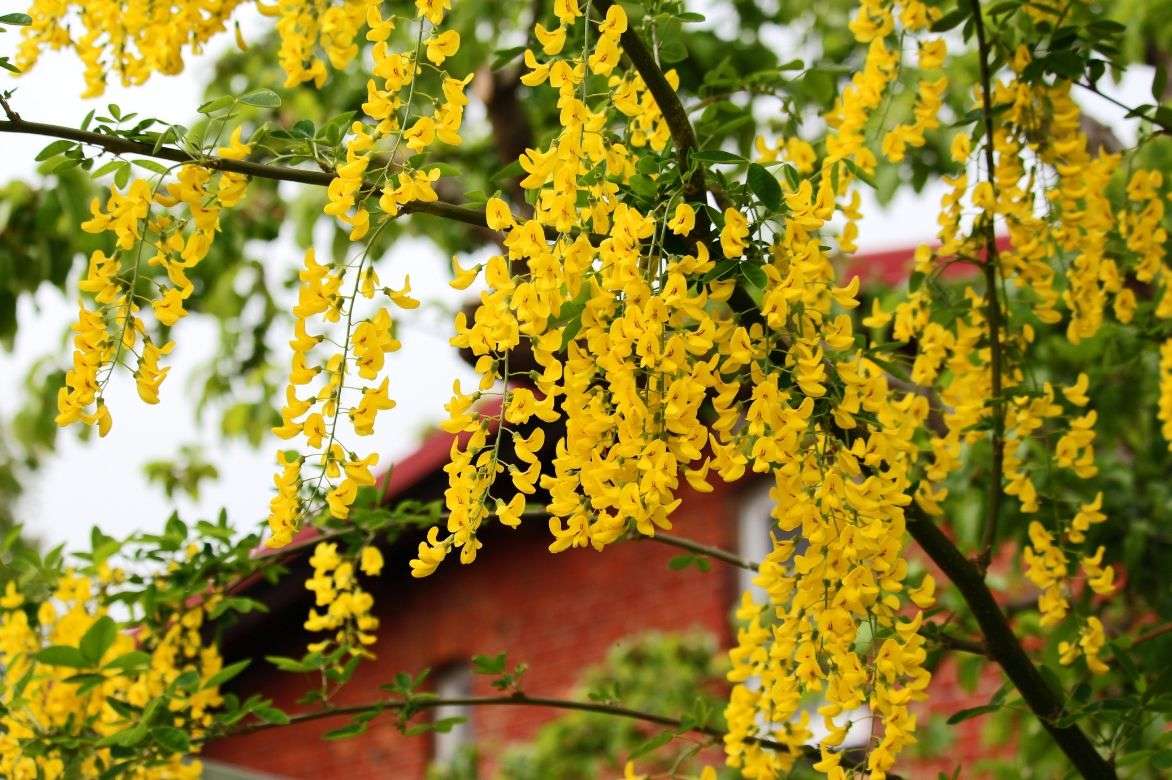
Fruiting appears as silky brown-grey pods, flat and bumpy, 5 to 10 cm long. They contain 2 to 7 brown or black seeds, flattened kidney-shaped, and are very toxic. Fruits persist on tree from July until spring.
Lifespan is on order of a century, often longer. Growth of these small trees is moderate to fast.
In the wild, laburnums are used to reforest and stabilise limestone soils. They are also a pioneer species thanks to ability to fix atmospheric nitrogen, thus preparing ground for establishment of other plants.
Read also
Wisteria: how to plant, prune and care?Our favourite varieties
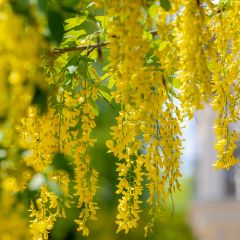
Laburnum anagyroides
- Flowering time June to August
- Height at maturity 8 m
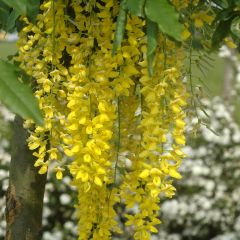
Laburnum x watereri Vossii
- Flowering time June, July
- Height at maturity 5 m
Discover other Laburnum
View all →Available in 1 sizes
Available in 1 sizes
Available in 3 sizes
Available in 1 sizes
Available in 1 sizes
Available in 1 sizes
Planting Cytisus
Where to plant?
Cytises are small native montane trees, which means they withstand both severe cold and heat: they tolerate very contrasting seasons.
They enjoy full sun but tolerate partial shade.
All types of soil suit them, even clay or calcareous soil provided it is well drained. Laburnum tolerates urban pollution well and copes with poor soil thanks to its ability to fix nitrogen.
When to plant?
Planting is best carried out in autumn, in November–December. However, planting can be postponed in heavy soil and done in spring in April–May.
How to plant?
- Re-wet the rootball by plunging the plant for a few minutes into water, then remove from pot
- Provide a hole twice the volume of the rootball
- Keep excavated soil and mix it with coarse sand and some gravel to lighten it, especially if soil is heavy
- Avoid placing a layer of gravel at the bottom of the hole to improve drainage as often suggested; this actually increases water stagnation near the roots. Rather add a few handfuls of potting compost to the bottom of the hole
- Place the rootball in the hole and fill with the excavated soil (mixed with sand and gravel)
- Firm soil lightly around base of plant
- Give a generous can of water to reduce risk of “air pockets” between substrate and roots
- Apply a mulch of dead leaves or BRF (ramial woodchip) at the base.
Pruning and maintenance
Care
Little maintenance is required. However, do not forget to water the tree during the first year after planting in summer if it has not rained for several days. Afterwards, the tree will manage on its own and will be very drought-resistant.
Like all members of the Fabaceae family (such as bean or sweet pea, for example), Cytise is able to fix atmospheric nitrogen via bacteria living in sym symbiosis near its roots. There is therefore no need to fertilise the soil to make it grow faster. It manages, here too, on its own and even benefits nearby young plants.
Pruning
A light pruning can be carried out to maintain an elegant habit to the tree and to remove dead wood. It will also be an opportunity to remove pods which are toxic. Pruning should be done just after flowering, from the end of July depending on species or hybrid.
Possible diseases and pests
Aphids, if very numerous, can cause development of sooty mould, a fungal disease recognised by blackening of foliage. It is not serious but somewhat unsightly. The only solution is to limit aphid numbers by favouring their natural predators (ladybird and hoverfly larvae, warblers…) or by spraying a preventive black soap solution.
Rust can also appear as small orange pustules on foliage during excessively wet springs. This is not serious either but the best way to avoid it is not to overwater and, above all, not to overcrowd young plants.
Slugs and snails sometimes nibble a little foliage on young trees, without consequence for the tree.
At the beginning and end of summer, a small dipteran, an Agromyza sp. belonging to the “leaf-mining flies” lays its eggs in the leaf lamina. The larva then tunnels through the leaves. It is a little unsightly, it must be admitted, but not dangerous for the tree. If this worries you, the only thing to do is crush these larvae by pinching the affected leaves.
→ Learn more about diseases and parasites of Cytise in our advice sheet.
Propagation: sowing, cutting
By sowing
Botanical Cytises often self-seed in the garden. In that case you can move your young trees in autumn to another spot or give them to a friend.
You can also encourage this by sowing in autumn a few seeds previously soaked for a few days in lukewarm water. Sow these seeds at a depth of 1 cm in a free-draining substrate: a mix of 1/3 general-purpose compost and 2/3 river sand. Place your sowings (in a seed tray or in a pot) in shade and keep moist but not waterlogged.
At the three-leaf stage, you can carefully prick them out into a bucket of compost. Wait until the following spring to replant in open ground, but not longer because trees and bushes of the Fabaceae family do not tolerate staying too long in a pot and establishment may be compromised.
By cutting
Cytises can also be propagated by cutting, especially those that do not self-seed.
In this case choose a few branch tips of about twenty centimetres in summer. Cut the base on a slant and remove the leaves except for the last two at the tip of the branch. A cutting needs a minimum of leaves but most should be removed to reduce evapotranspiration. Place your cuttings in pots in a light substrate: a mix of 2/3 compost and 1/3 river sand. Plant your rooted cuttings in open ground the following spring.
Companion plants for Cytisus
A flowering hedge for all four seasons
Laburnum anagyroides will be right at home within a free-flowing, flowering country hedge left to grow freely. Pair it with a handsome lilac ‘Capitaine Baltet’ and a Philadelphus coronarius ‘Aureus’ to flower in spring. A Heptacodium miconioides can then create a lovely effect between summer and autumn, while a Hamamelis ‘Pallida’ and a Japanese quince ‘Eximia’ will brighten winter. And why not try a Japanese wisteria, such as variety ‘Okayama’, trained as a tree to accompany its yellow-flowered cousin?
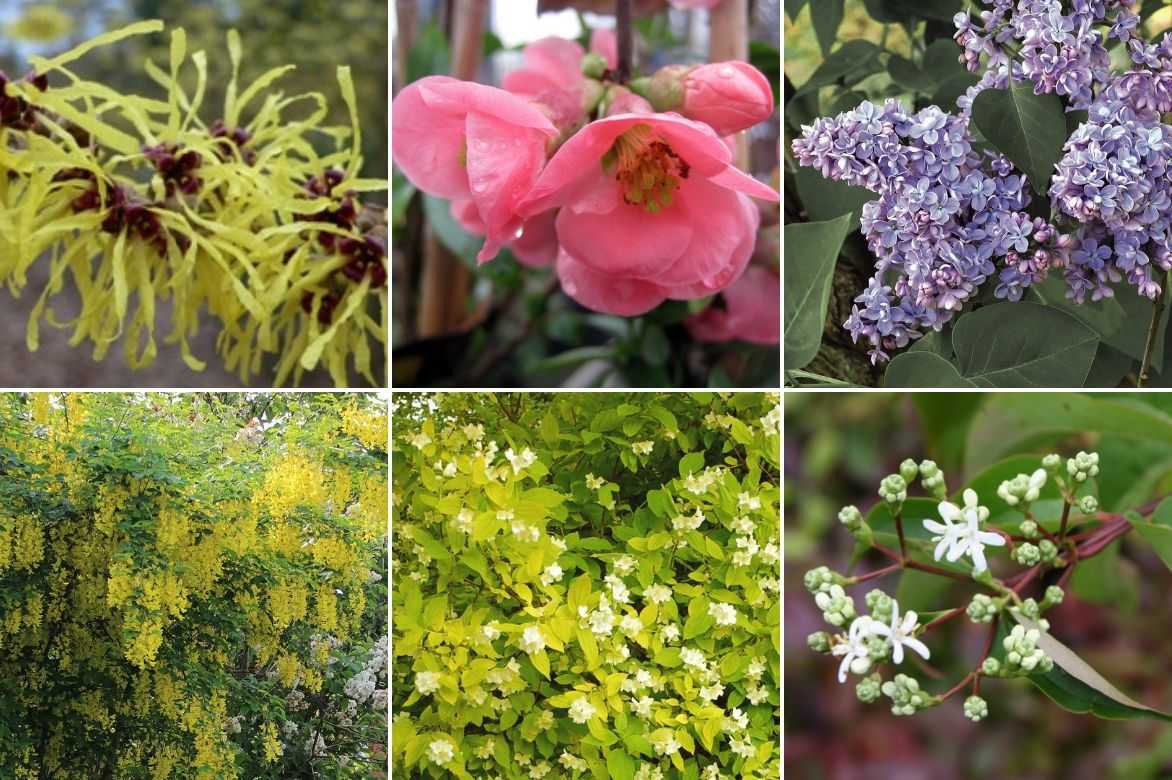
An example of a four-season hedge combination: Hamamelis pallida, Chaenomeles speciosa ‘Eximia’, Syringa vulgaris ‘Capitaine Baltet’, Laburnum anagyroides, Philadelphus coronarius ‘Aureus’ and Heptacodium miconioides
A canopy of golden rain
Imagine a long path in your garden, punctate here and there along both sides with a few Laburnum x watereri ‘Vossii’. These will grow and shoot until their branches meet, forming a vault of branches and leaves. But it doesn’t stop there! Once flowering arrives in spring, the clusters will literally spill towards you in a fantastic, lightly scented golden rain. Yellow flower tones can be enhanced by a complementary colour — blue-violet — using a few alliums ‘Purple Sensation’ or Muscari armeniacum ‘Big Smile’ scattered at the base of the trees.
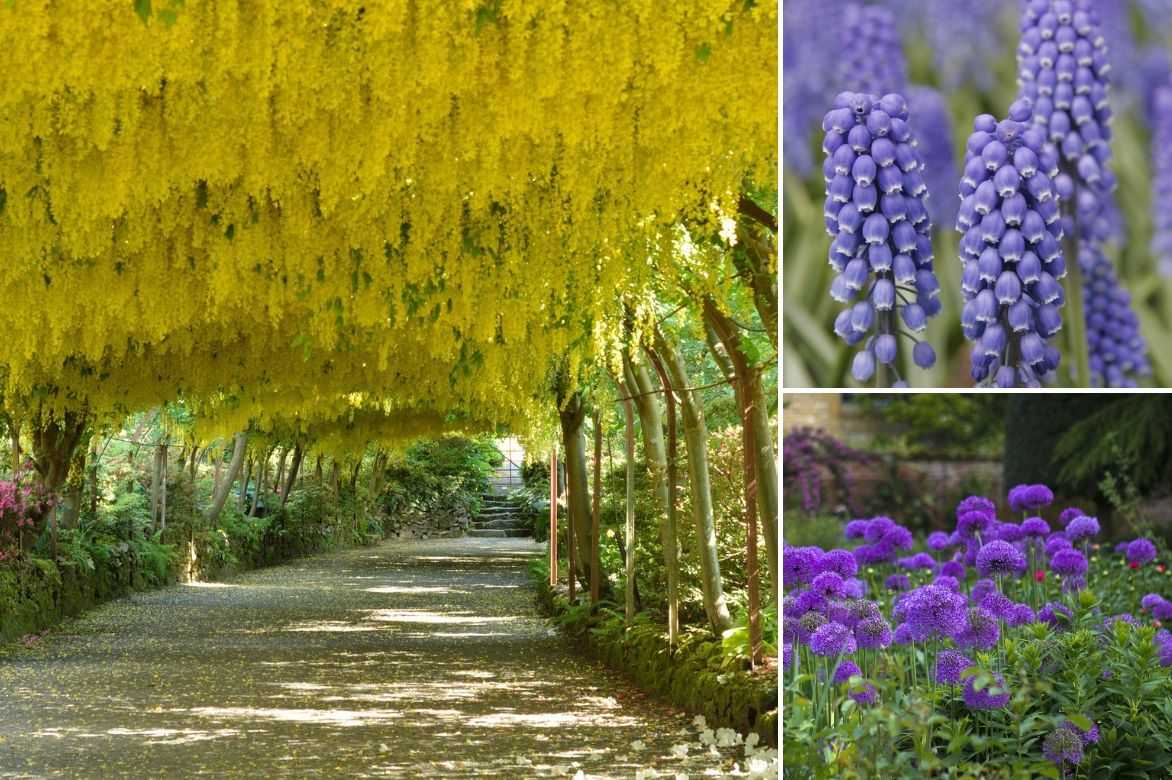
Another idea for a combination: Laburnum watereri ‘Vossii’, Muscari armeniacum ‘Big Smile’ and Allium aflatunense ‘Purple Sensation’
→ Discover other ideas for pairing with laburnum in our advice sheet !
Did you know?
- Entire plant is toxic (even the pods!) due to presence of various alkaloids with acute toxicity. There have already been cases of poisoning in horses, sheep and goats but also in humans. Exercise caution… Poison is also found in bodies of caterpillars and larvae of a leaf‑miner fly that feed on leaves, making them inedible to their natural predators.
- Laburnum attracts many pollinating insects, notably an impressive number of bumblebees of different species.
- In the 18th century, curator of the Chelsea botanical garden, Phillip Miller, gave it the scientific name Cytisus. In 1830, Czech botanist Jan Svatopluk Presl decided to include it in the genus Laburnum.
- Bodnant Garden in Conwy, Wales, is famous for its arch composed entirely of Laburnum x watereri ‘Vossii’, more than 50 metres long.
- In 1826, a graft of the broom Cytisus purpureus onto a trunk of Laburnum anagyroides was attempted in a Parisian nursery. A rare phenomenon, the two trees fused their genetic material, producing a curious hybrid: Laburnocytisus adamii. This strange bush produces branches bearing yellow flowers and branches bearing purple flowers…
- The Laburnum alpinum planted in 1601 at Leiden botanical garden in the Netherlands is still alive today.
- Laburnum wood is so dark that some nicknamed it the “false ebony”. This wood has been used to make furniture and tool handles. Wood of Laburnum alpinum is still used today to craft high‑quality bows.
- Dried leaves of Laburnum anagyroides are used in phytotherapy for their effects on the gallbladder.
Useful resources
- Find our Laburnum in our online nursery.
- Laburnum is not the only small tree with exceptional flowering, find here our selection of 7 essential flowering trees for the garden.
- Sometimes yellow is a little too… yellow. It’s often appropriate to temper this tone slightly in the garden, find all our tips in this article.
- Discover our advice sheet on trees with a weeping habit
- Discover 7 bushes with yellow flowers
- Subscribe!
- Contents
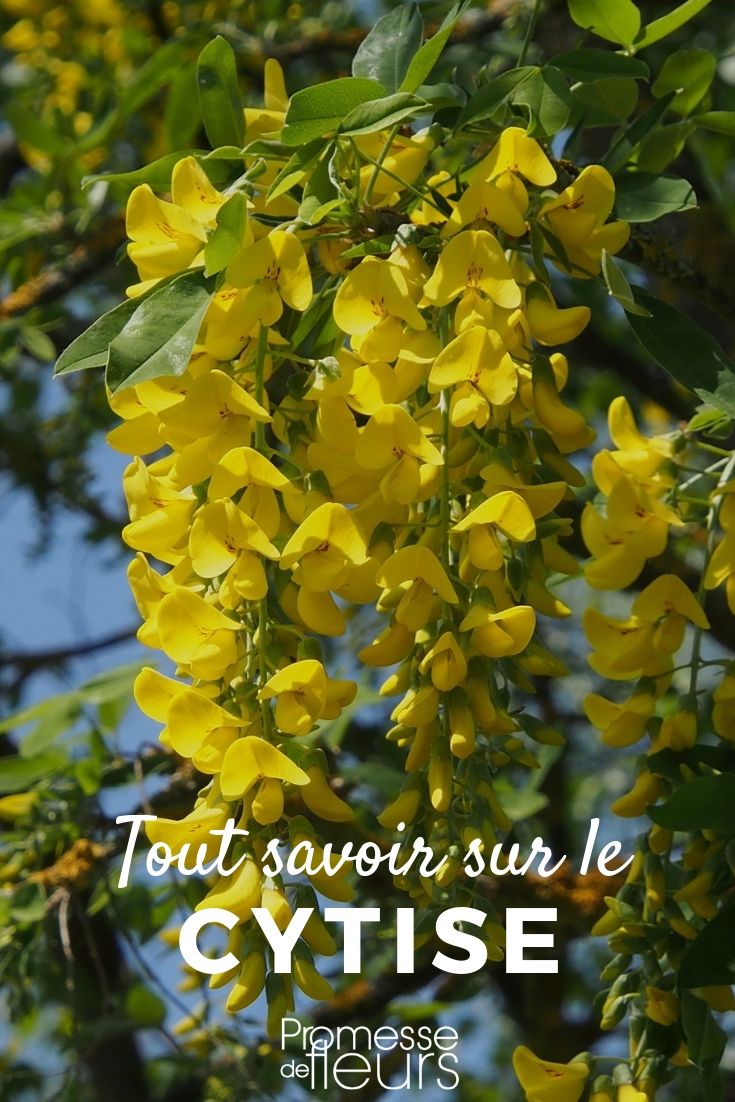































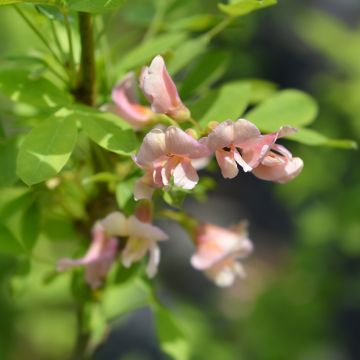
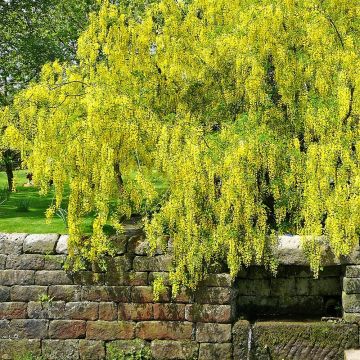

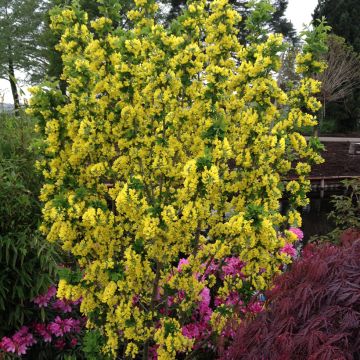
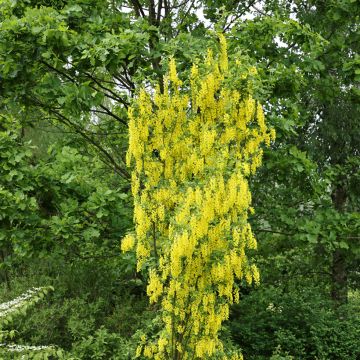

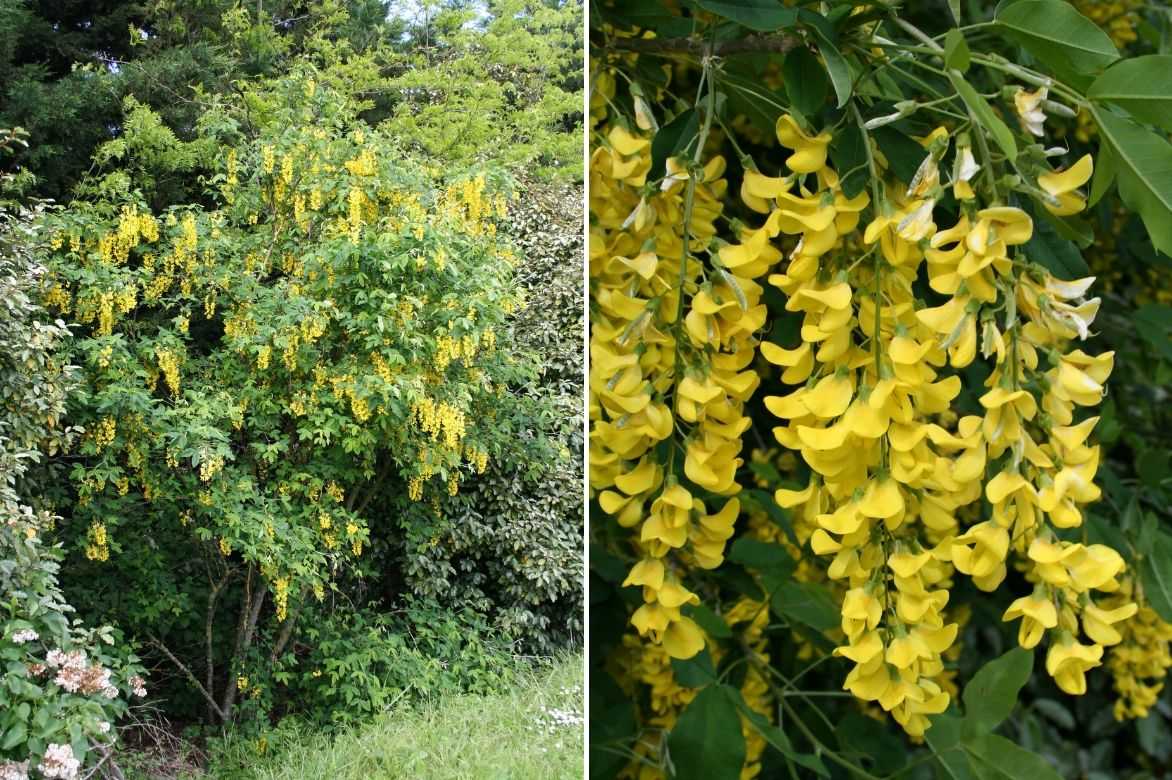
Comments